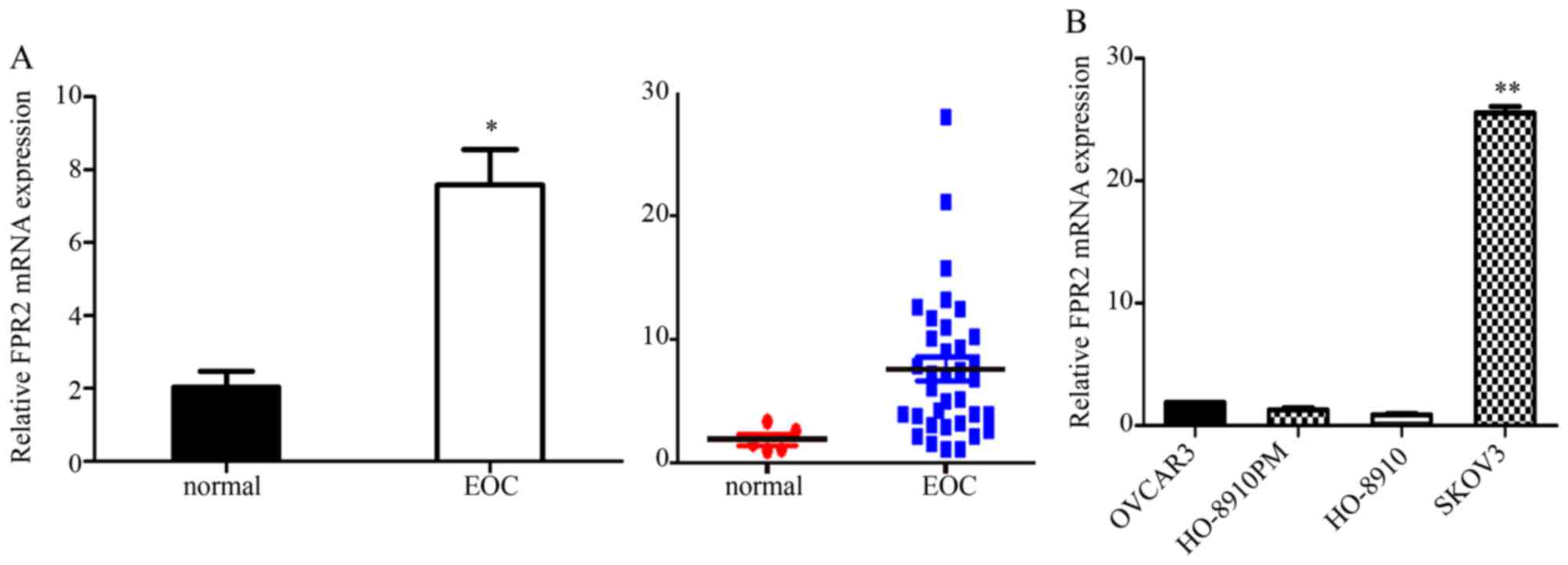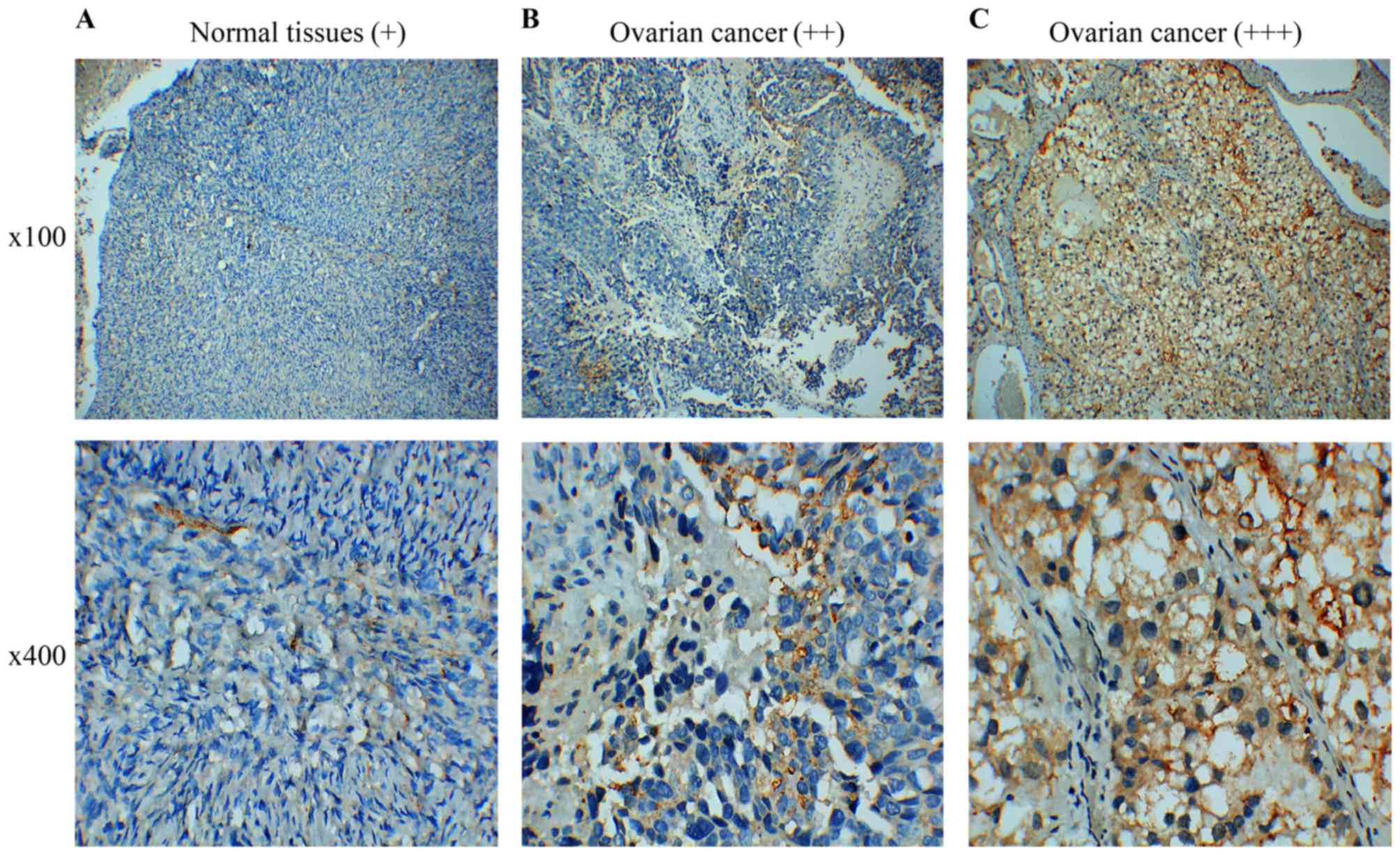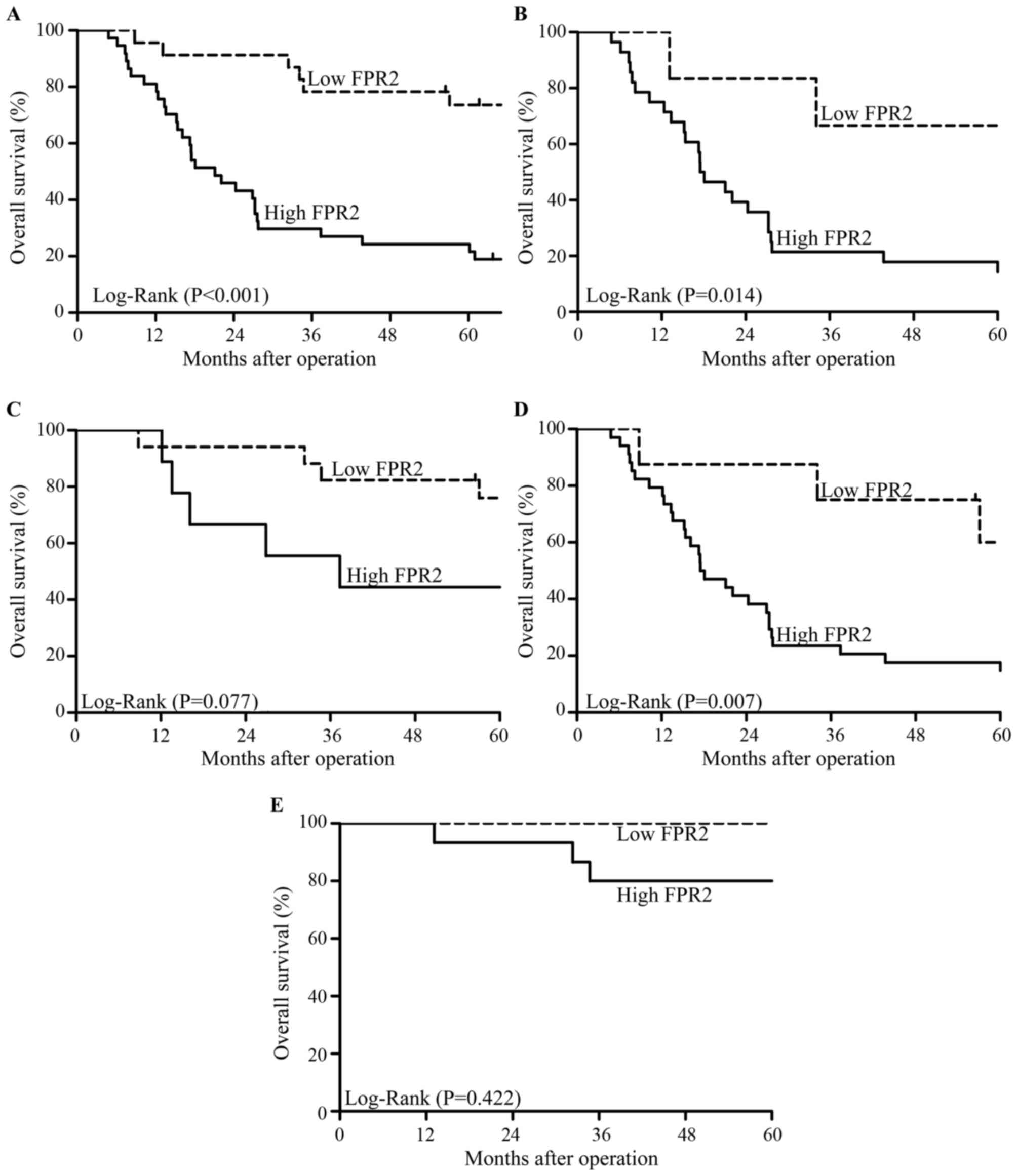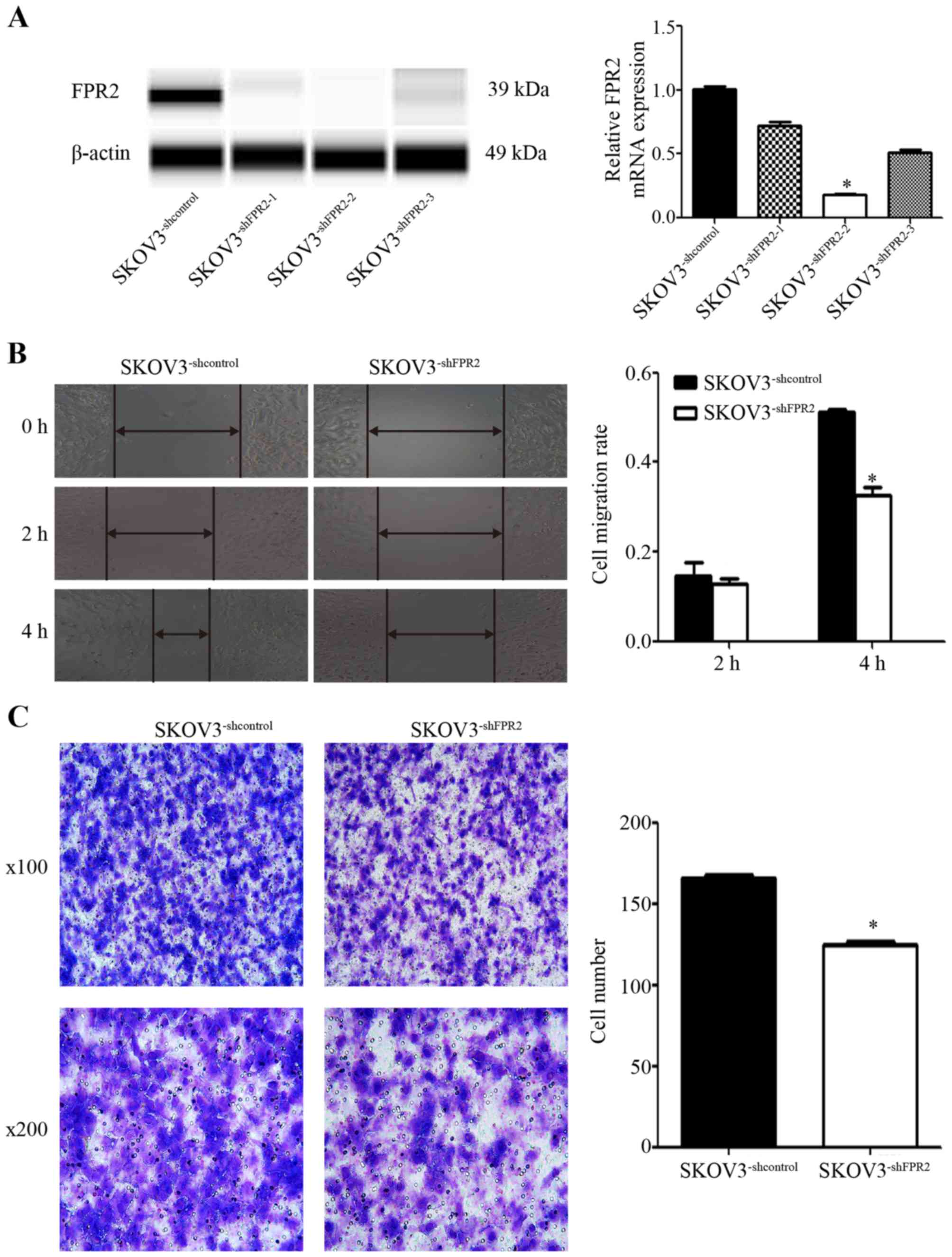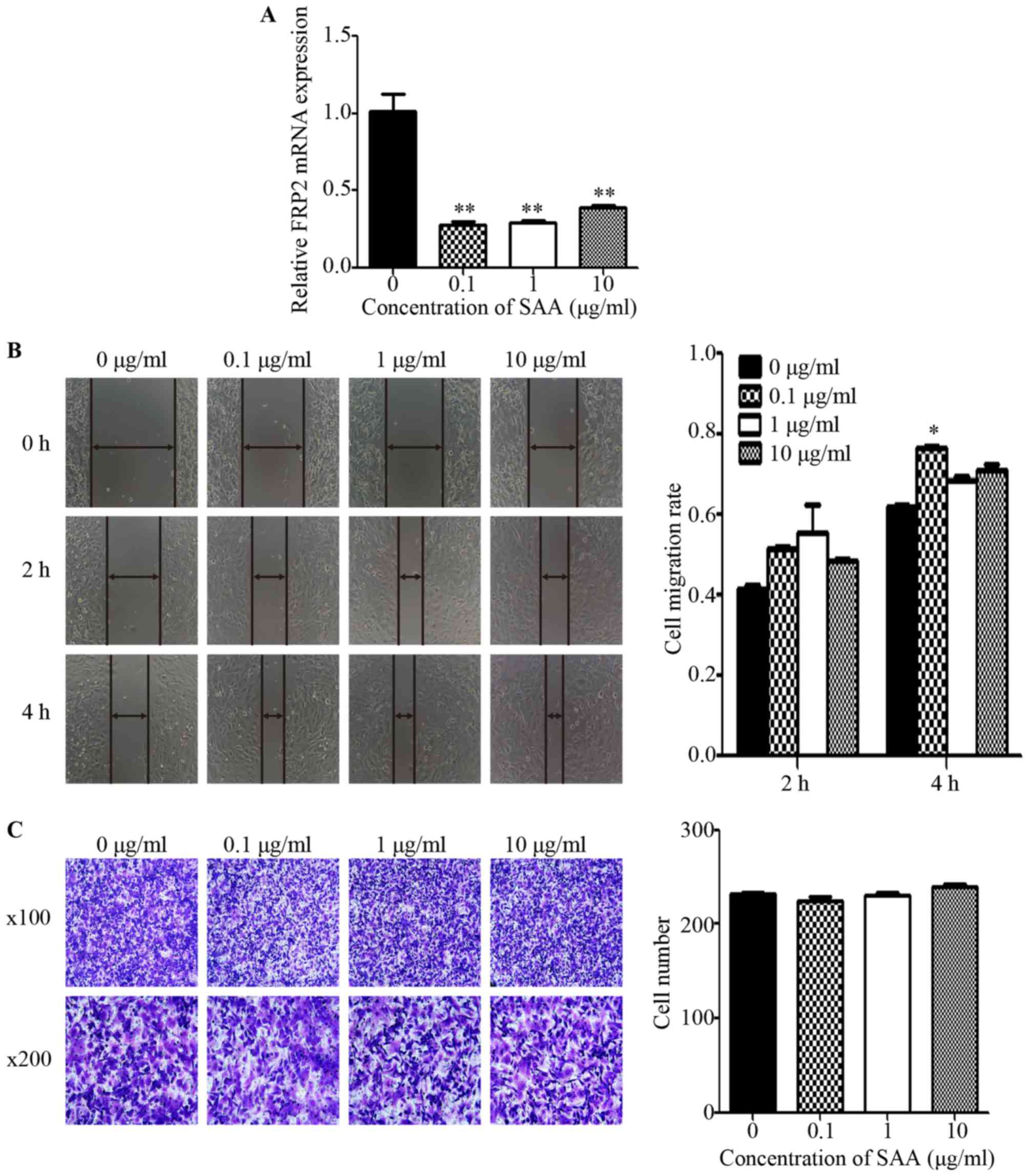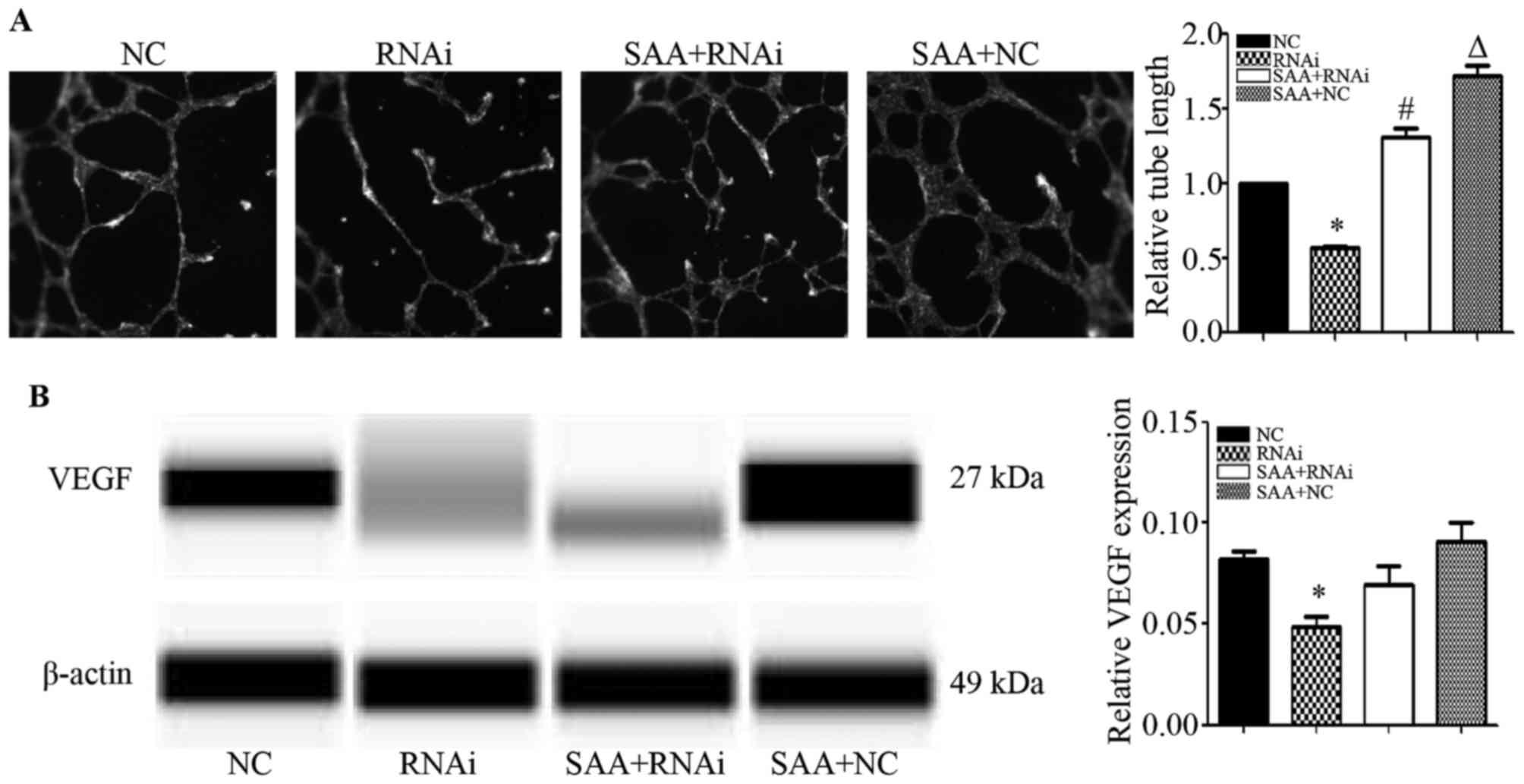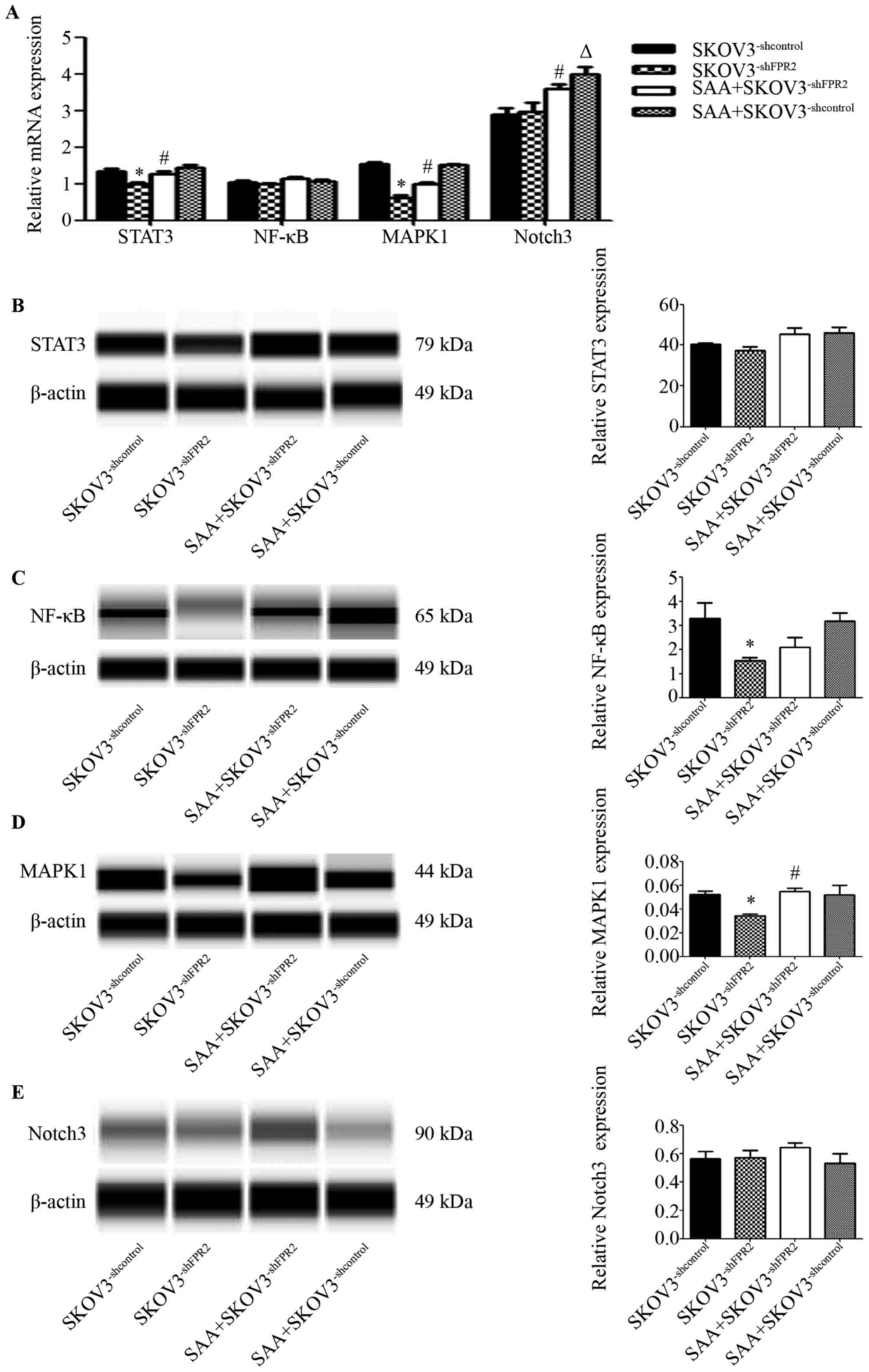|
1
|
Siegel RL, Miller KD and Jemal A: Cancer
Statistics, 2017. CA Cancer J Clin. 67:7–30. 2017. View Article : Google Scholar : PubMed/NCBI
|
|
2
|
Chen W: Cancer statistics: Updated cancer
burden in China. Chin J Cancer Res. 27:12015. View Article : Google Scholar : PubMed/NCBI
|
|
3
|
Herzog TJ and Pothuri B: Ovarian cancer: A
focus on management of recurrent disease. Nat Clin Pract Oncol.
3:604–611. 2006. View Article : Google Scholar : PubMed/NCBI
|
|
4
|
Malpica A, Deavers MT, Lu K, Bodurka DC,
Atkinson EN, Gershenson DM and Silva EG: Grading ovarian serous
carcinoma using a two-tier system. Am J Surg Pathol. 28:496–504.
2004. View Article : Google Scholar : PubMed/NCBI
|
|
5
|
Kurman RJ and Shih IeM: The origin and
pathogenesis of epithelial ovarian cancer: A proposed unifying
theory. Am J Surg Pathol. 34:433–443. 2010. View Article : Google Scholar : PubMed/NCBI
|
|
6
|
Hunn J and Rodriguez GC: Ovarian cancer:
Etiology, risk factors, and epidemiology. Clin Obstet Gynecol.
55:3–23. 2012. View Article : Google Scholar : PubMed/NCBI
|
|
7
|
Lin HW, Tu YY, Lin SY, Su WJ, Lin WL, Lin
WZ, Wu SC and Lai YL: Risk of ovarian cancer in women with pelvic
inflammatory disease: A population-based study. Lancet Oncol.
12:900–904. 2011. View Article : Google Scholar : PubMed/NCBI
|
|
8
|
Risch HA and Howe GR: Pelvic inflammatory
disease and the risk of epithelial ovarian cancer. Cancer Epidemiol
Biomarkers Prev. 4:447–451. 1995.PubMed/NCBI
|
|
9
|
Seidman JD, Sherman ME, Bell KA, Katabuchi
H, O'Leary TJ and Kurman RJ: Salpingitis, salpingoliths, and serous
tumors of the ovaries: Is there a connection? Int J Gynecol Pathol.
21:101–107. 2002. View Article : Google Scholar : PubMed/NCBI
|
|
10
|
Ye RD, Boulay F, Wang JM, Dahlgren C,
Gerard C, Parmentier M, Serhan CN and Murphy PM: International
Union of Basic and Clinical Pharmacology. LXXIII. Nomenclature for
the formyl peptide receptor (FPR) family. Pharmacol Rev.
61:119–161. 2009. View Article : Google Scholar : PubMed/NCBI
|
|
11
|
Becker EL, Forouhar FA, Grunnet ML, Boulay
F, Tardif M, Bormann BJ, Sodja D, Ye RD, Woska JR Jr and Murphy PM:
Broad immunocytochemical localization of the formylpeptide receptor
in human organs, tissues, and cells. Cell Tissue Res. 292:129–135.
1998. View Article : Google Scholar : PubMed/NCBI
|
|
12
|
Migeotte I, Communi D and Parmentier M:
Formyl peptide receptors: A promiscuous subfamily of G
protein-coupled receptors controlling immune responses. Cytokine
Growth Factor Rev. 17:501–519. 2006. View Article : Google Scholar : PubMed/NCBI
|
|
13
|
Li Y and Ye D: Molecular biology for
formyl peptide receptors in human diseases. J Mol Med. 91:781–789.
2013. View Article : Google Scholar : PubMed/NCBI
|
|
14
|
Coffelt SB, Tomchuck SL, Zwezdaryk KJ,
Danka ES and Scandurro AB: Leucine leucine-37 uses formyl peptide
receptor-like 1 to activate signal transduction pathways, stimulate
oncogenic gene expression, and enhance the invasiveness of ovarian
cancer cells. Mol Cancer Res. 7:907–915. 2009. View Article : Google Scholar : PubMed/NCBI
|
|
15
|
Urieli-Shoval S, Finci-Yeheskel Z, Dishon
S, Galinsky D, Linke RP, Ariel I, Levin M, Ben-Shachar I and Prus
D: Expression of serum amyloid a in human ovarian epithelial
tumors: Implication for a role in ovarian tumorigenesis. J
Histochem Cytochem. 58:1015–1023. 2010. View Article : Google Scholar : PubMed/NCBI
|
|
16
|
Liang TS, Wang JM, Murphy PM and Gao JL:
Serum amyloid A is a chemotactic agonist at FPR2, a low-affinity
N-formylpeptide receptor on mouse neutrophils. Biochem
Biophys Res Commun. 270:331–335. 2000. View Article : Google Scholar : PubMed/NCBI
|
|
17
|
Ren SW, Qi X, Jia CK and Wang YQ: Serum
amyloid A and pairing formyl peptide receptor 2 are expressed in
corneas and involved in inflammation-mediated neovascularization.
Int J Ophthalmol. 7:187–193. 2014.PubMed/NCBI
|
|
18
|
Yang M, Liu F and Higuchi K, Sawashita J,
Fu X, Zhang L, Zhang L, Fu L, Tong Z and Higuchi K: Serum amyloid A
expression in the breast cancer tissue is associated with poor
prognosis. Oncotarget. 7:35843–35852. 2016.PubMed/NCBI
|
|
19
|
Romero I and Bast RC Jr: Minireview: Human
ovarian cancer: Biology, current management, and paths to
personalizing therapy. Endocrinology. 153:1593–1602. 2012.
View Article : Google Scholar : PubMed/NCBI
|
|
20
|
Oldekamp S, Pscheidl S, Kress E, Soehnlein
O, Jansen S, Pufe T, Wang JM, Tauber SC and Brandenburg LO: Lack of
formyl peptide receptor 1 and 2 leads to more severe inflammation
and higher mortality in mice with of pneumococcal meningitis.
Immunology. 143:447–461. 2014. View Article : Google Scholar : PubMed/NCBI
|
|
21
|
Xiang Y, Yao X, Chen K, Wang X, Zhou J,
Gong W, Yoshimura T, Huang J, Wang R, Wu Y, et al: The G-protein
coupled chemoattractant receptor FPR2 promotes malignant phenotype
of human colon cancer cells. Am J Cancer Res. 6:2599–2610.
2016.PubMed/NCBI
|
|
22
|
Khau T, Langenbach SY, Schuliga M, Harris
T, Johnstone CN, Anderson RL and Stewart AG: Annexin-1 signals
mitogen-stimulated breast tumor cell proliferation by activation of
the formyl peptide receptors (FPRs) 1 and 2. FASEB J. 25:483–496.
2011. View Article : Google Scholar : PubMed/NCBI
|
|
23
|
Wang J, Sharma A, Ghamande SA, Bush S,
Ferris D, Zhi W, He M, Wang M, Wang X, Miller E, et al: Serum
protein profile at remission can accurately assess therapeutic
outcomes and survival for serous ovarian cancer. PLoS One.
8:e783932013. View Article : Google Scholar : PubMed/NCBI
|
|
24
|
Sodin-Semrl S, Spagnolo A, Mikus R,
Barbaro B, Varga J and Fiore S: Opposing regulation of
interleukin-8 and NF-kappaB responses by lipoxin A4 and serum
amyloid A via the common lipoxin A receptor. Int J Immunopathol
Pharmacol. 17:145–156. 2004. View Article : Google Scholar : PubMed/NCBI
|
|
25
|
Badolato R, Wang JM, Murphy WJ, Lloyd AR,
Michiel DF, Bausserman LL, Kelvin DJ and Oppenheim JJ: Serum
amyloid A is a chemoattractant: Induction of migration, adhesion,
and tissue infiltration of monocytes and polymorphonuclear
leukocytes. J Exp Med. 180:203–209. 1994. View Article : Google Scholar : PubMed/NCBI
|
|
26
|
Yazawa H, Yu ZX, Takeda, Le Y, Gong W,
Ferrans VJ, Oppenheim JJ, Li CC and Wang JM: β amyloid peptide
(Aβ42) is internalized via the G-protein-coupled receptor FPRL1 and
forms fibrillar aggregates in macrophages. FASEB J. 15:2454–2462.
2001. View Article : Google Scholar : PubMed/NCBI
|
|
27
|
Duvernay MT, Filipeanu CM and Wu G: The
regulatory mechanisms of export trafficking of G protein-coupled
receptors. Cell Signal. 17:1457–1465. 2005. View Article : Google Scholar : PubMed/NCBI
|
|
28
|
Byrne AT, Ross L, Holash J, Nakanishi M,
Hu L, Hofmann JI, Yancopoulos GD and Jaffe RB: Vascular endothelial
growth factor-trap decreases tumor burden, inhibits ascites, and
causes dramatic vascular remodeling in an ovarian cancer model.
Clin Cancer Res. 9:5721–5728. 2003.PubMed/NCBI
|
|
29
|
Perren TJ, Swart AM, Pfisterer J,
Ledermann JA, Pujade-Lauraine E, Kristensen G, Carey MS, Beale P,
Cervantes A, Kurzeder C, et al: ICON7 Investigators: A phase 3
trial of bevacizumab in ovarian cancer. N Engl J Med.
365:2484–2496. 2011. View Article : Google Scholar : PubMed/NCBI
|
|
30
|
Lu Q, Quan W, Wu J, Zhang X, Ma W, Pang L
and Li D: Effect of antibacterial peptide hCAP18/LL-37 on ovarian
cancer microenvironment and the regulatory mechanism of its
expression. Zhonghua Zhong Liu Za Zhi. 37:725–730. 2015.(In
Chinese). PubMed/NCBI
|
|
31
|
Pesic M and Greten FR: Inflammation and
cancer: Tissue regeneration gone awry. Curr Opin Cell Biol.
43:55–61. 2016. View Article : Google Scholar : PubMed/NCBI
|
|
32
|
Karin M and Clevers H: Reparative
inflammation takes charge of tissue regeneration. Nature.
529:307–315. 2016. View Article : Google Scholar : PubMed/NCBI
|
|
33
|
Kim BH, Yi EH and Ye SK: Signal transducer
and activator of transcription 3 as a therapeutic target for cancer
and the tumor microenvironment. Arch Pharm Res. 39:1085–1099. 2016.
View Article : Google Scholar : PubMed/NCBI
|
|
34
|
Cai L, Zhang G, Tong X, You Q, An Y, Wang
Y, Guo L, Wang T, Zhu D and Zheng J: Growth inhibition of human
ovarian cancer cells by blocking STAT3 activation with small
interfering RNA. Eur J Obstet Gynecol Reprod Biol. 148:73–80. 2010.
View Article : Google Scholar : PubMed/NCBI
|
|
35
|
Cattaneo F, Parisi M and Ammendola R:
WKYMVm-induced cross-talk between FPR2 and HGF receptor in human
prostate epithelial cell line PNT1A. FEBS Lett. 587:1536–1542.
2013. View Article : Google Scholar : PubMed/NCBI
|
|
36
|
Kam AY, Liu AM and Wong YH: Formyl
peptide-receptor like-1 requires lipid raft and extracellular
signal-regulated protein kinase to activate inhibitor-kappa B
kinase in human U87 astrocytoma cells. J Neurochem. 103:1553–1566.
2007. View Article : Google Scholar : PubMed/NCBI
|
|
37
|
Manzano RG, Montuenga LM, Dayton M, Dent
P, Kinoshita I, Vicent S, Gardner GJ, Nguyen P, Choi YH, Trepel J,
et al: CL100 expression is down-regulated in advanced epithelial
ovarian cancer and its re-expression decreases its malignant
potential. Oncogene. 21:4435–4447. 2002. View Article : Google Scholar : PubMed/NCBI
|
|
38
|
Kim D and Haynes CL: The role of p38 MAPK
in neutrophil functions: Single cell chemotaxis and surface marker
expression. Analyst. 138:6826–6833. 2013. View Article : Google Scholar : PubMed/NCBI
|
|
39
|
Park JT, Li M, Nakayama K, Mao TL,
Davidson B, Zhang Z, Kurman RJ, Eberhart CG, Shih IeM and Wang TL:
Notch3 gene amplification in ovarian cancer. Cancer Res.
66:6312–6318. 2006. View Article : Google Scholar : PubMed/NCBI
|



